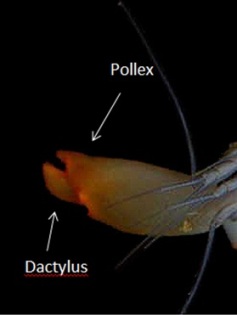
Sabotage, Implosions, and Regeneration
Alpheus
randalli’s Spooky Story
After reading about Alpheus randalli,
you may wonder what is so spooky about this shrimp. It is so
tiny, how could it cause any harm? Truth is this shrimp can
stun its prey, enemies and other organisms with just a snap of its claw!
This snap creates a loud crack that can be audible up to one
kilometer away. When large groups of Alpheid shrimp are making
the snapping noises, it can interfere with sonar systems, which
have caused a lot of investigations ever since World War II.
There have been multiple incidences reported from U.S.
submarines. In 1942, a submarine in the Macassar Straight went
through a group of Pistol Shrimp which spooked many sailors on
board. Luitenent Commander W. D. Wilkins said “the Japs may
have some newfangled gadget that they drop.” Thus it is evident
that these snapping shrimp of any Alpheus species
caused quite a scare during World War II. (Johnson, et. al.
1947)
So what allows this tiny creature to pack such a punch? The
major chela, the larger of the two claws, has two parts, the
dactylus, the movable finger, and the pollex, the immovable.
The two work together by the dactylus quickly closing onto the
pollex. The dactylus and pollex are normally held open, but
when they do close, it happens very very quickly (BBC news
2000). This is very similar to the hammer of a pistol, hence
the name Pistol Shrimp (Spence and Knowlton 2008). The noise,
however, does not come from the claw itself closing. It comes
from the air bubble created after. When the claw closes, it
creates a high velocity jet of water. Tiny bubbles expand
because the pressure of the water around them is lower than the
vapor pressure of water due to the high velocity of the water
jet. The pressure quickly comes back up to normal, imploding
the bubbles on themselves, which creates the popping noise (BBC
news 2000). As you learned in the
Interactions section of this website, Alpheus randalli
uses this process to stun its prey and to communicate with other
members of its species (BBC news 2000).
There is something even more impressive about this process.
The jet of water can reach velocities up to 60 miles per hour,
which makes it understandable how this creates a drop in
pressure. When the bubble collapses, the snapping sound that it
makes can get up to 218 decibels, which is louder than a jet
engine. If that’s hard to believe, the next part will be even
more unbelievable. This same bubble creates a small flash of
light and, for a fraction of a second, the temperatures inside
can reach 8000 degrees Fahrenheit (Derbyshire 2008). This is
just under the surface temperature of the sun! And to think
this all comes from a tiny shrimp that can fit in the palm of
your hand. No wonder the goby fish love forming a symbiotic
relationship with these shrimp.
To see this claw in action, check out this
video!
If this is not crazy enough for you, Pistol Shrimp in the
Alpheus genus can regenerate! This is not quite like
bringing Frankenstein back to life, but it is still pretty
impressive. If the shrimp loses or permanently damages its
snapping claw, it will grow it back with one minor change. The
smaller claw, or pincer, on the opposite side will grow into the large
snapping claw, while the damaged appendage grows a pincer.
This is possible because both sides have the ability to grow
into a large snapping claw. Now you may ask why they both
don’t grow into snapping claws. This is because as one
grows into the large snapping claw, it inhibits the other one.
When it is damaged or removed, the inhibiting factor is gone and
the pincer grows into the large snapping claw. The newly grown
snapping claw then inhibits the pincer, growing where the
last snapping claw was lost, from getting too large. This could
potentially go back and forth infinitely (Read and Govind 1997).
For more interesting facts, head to the
Fun Facts section of the website!

